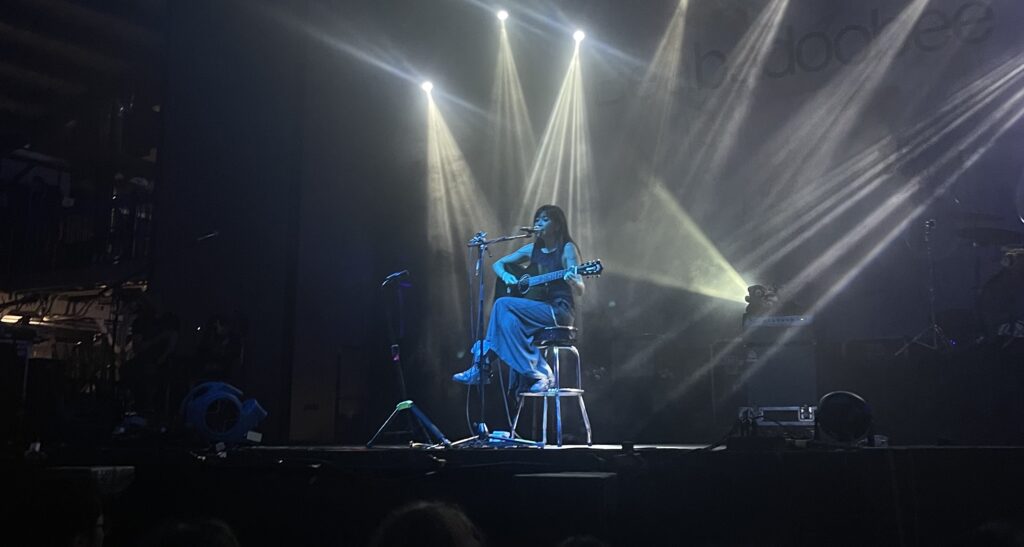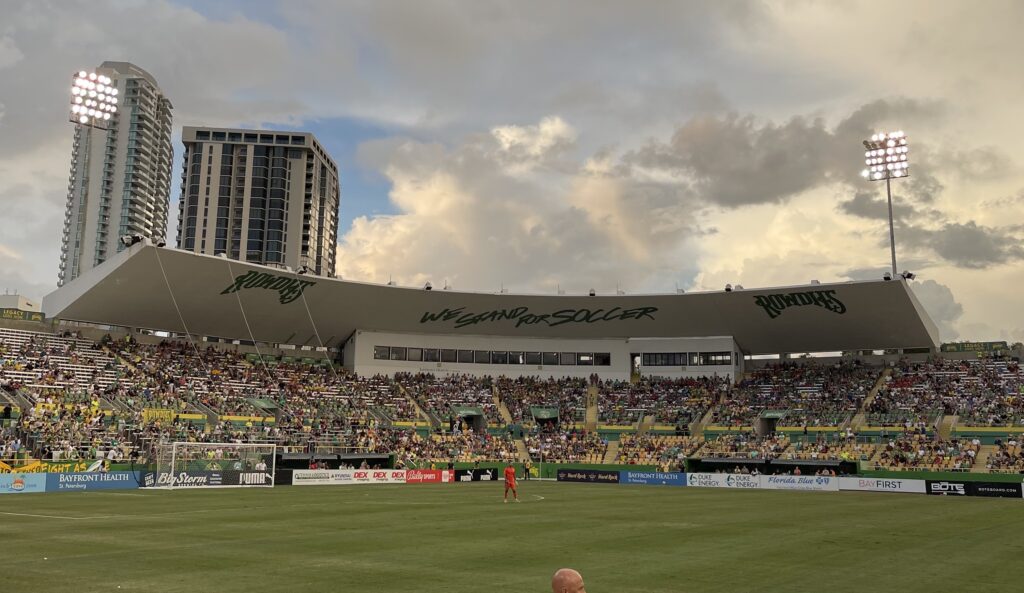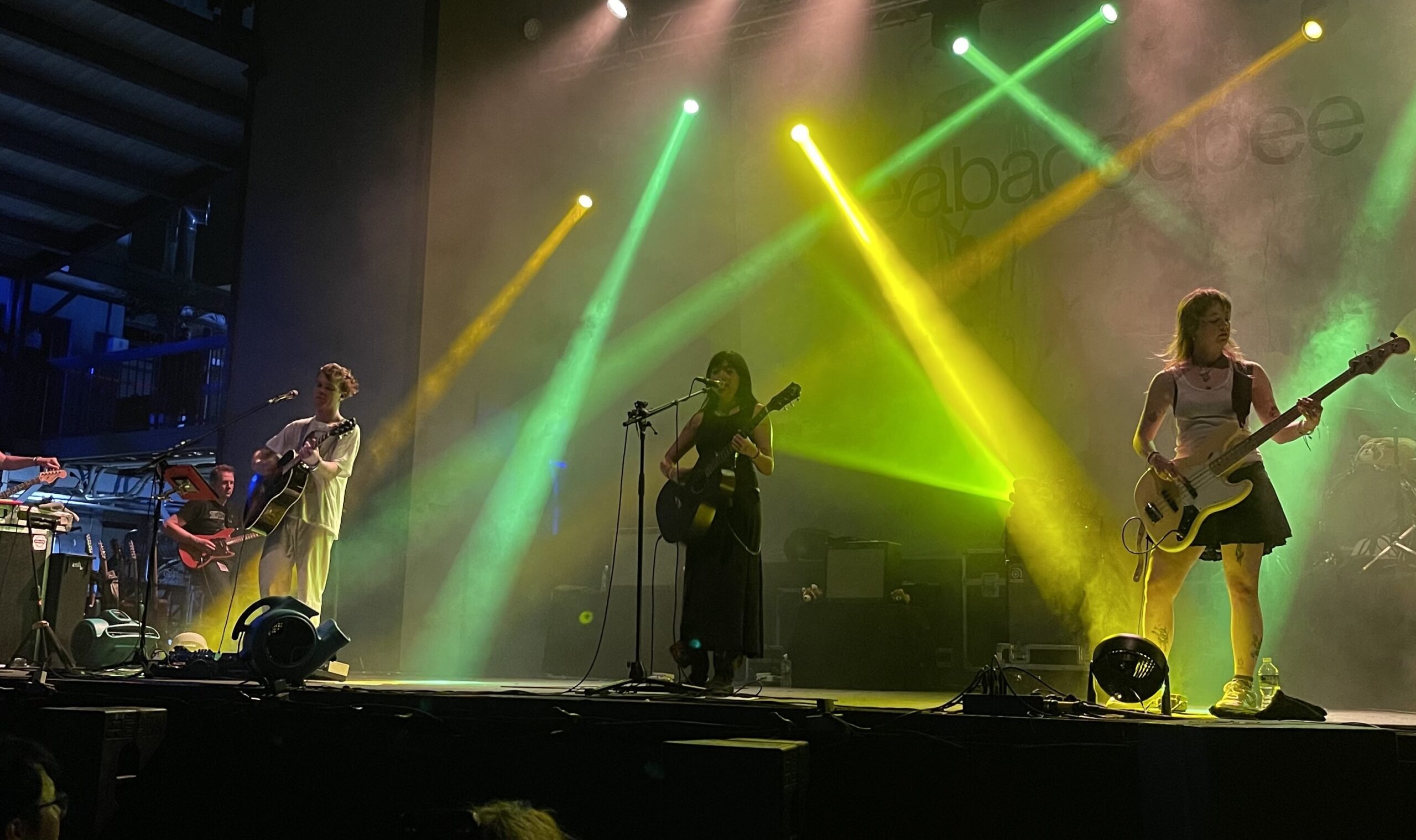Musician, Beabadoobee, and her band performing at Jannus Live in St. Petersburg, FL, in 2022.
Photo by Riley Benson
By Riley Benson
Once a place of tropical tranquility, St. Petersburg has slowly expanded into the bustling city it is today.
St. Petersburg has become a hub for events and nightlife, including significant events like the Firestone Grand Prix, Reggae Rise Up and more. While this evolution has led to an increase in residents, it has also increased the noise.
Noise pollution is one of the lesser-discussed issues that can have harmful effects on the people and wildlife of an area. Because of its lack of immediate threat, compared to water and air pollution, noise pollution tends to go unnoticed. Yet, cities regardless of size can fall victim to it.
“Problems related to noise include stress related illnesses, [like] high blood pressure, speech interference, hearing loss, sleep disruption and lost productivity,” the United States Environmental Protection Agency (EPA) documents. “Noise induced hearing loss is the most common and often discussed health effect, but research has shown that exposure to constant or high levels of noise can cause countless adverse health affects.”
When measuring hearing damage and noise’s impact on human ears, noise is measured in decibels (dB) units. The higher the decibels, the more noise the ears can take in. The Centers for Disease Control and Prevention (CDC) reported what each level of dB is and what it can do to a person’s hearing.
“How loud something sounds to you is not the same as the actual intensity of that sound. Sound intensity is the amount of sound energy in a confined space,” the CDC states. “The risk of damaging your hearing from noise increases with the sound intensity, not the loudness of the sound.”
According to the CDC, prolonged exposure of at least 70 dB can damage a person’s ears. While over 120 dB can cause immediate damage to someone’s hearing.
Noise pollution is an invisible threat in St. Petersburg, but not a silent one.
The Crow’s Nest went to the most popular spots in town at around 8:30 p.m. to investigate if dBs were enough to cause damage. Central Avenue, is full of bars, clubs and Jannus Live, a local concert venue which on a typical Saturday night had noise that reaches 109 dB.
The average dB of the entire area was around 79.1, with the dB of each location on Central ranging between 78.2 to 80.2.

Graphic by Riley Benson
Noise pollution is ever present in St. Petersburg and can be caused by various factors, including car traffic and nightly socializing, as previously mentioned. Yet another cause possibly contributing to the noise is the music scene.
The newly announced Rise Up concert series, produced by Rise Up St. Pete and Pier Events, recently made headlines. Its pier concert series featured various music artists performing between Nov. 2023 to Jan. 2024 on the St. Petersburg Pier.
Since this concert series was in collaboration with the St. Pete Pier, extensive safety measures were in place to ensure that all events work with city ordinances and follow the Pier’s own protocols that focus on the safety of guests.
“[The Pier does] what we call third-party events. So anyone is welcome to host an event on the pier, they just have to go through the different steps and protocol we have in our event booking Guide, which is actually open to the public,” says Hannah Keenan.
Keenan is the events manager with Pier Events LLC. Pier Events is contracted out with the City of St. Pete to bring events onto the Pier. She also ensures that event hosts have all the permits, park fees and everything paid to rent the space and that their events can go off without a hitch.
“All of our events we make sure there’s accessibility for everyone. We want to ensure that anyone can enjoy the concert or the events that we put on. Noise level wise, there in the city ordinance that we follow for the 10pm cut off to ensure that local residents and others to enjoy the concert and not disrupt the community,” Keenan said.
The Pier’s Event Booking Guide, with its protocols, is publicly available and it goes into detail about the safety measures taken to protect attendees and locals from the noise. More specifically, the Pier’s location on the waterfront and how this could amplify noise made, as it states, “Sound may travel greater distances over the water so that at times some of the sound may be briefly audible at a distance greater.”
Concerts typically average between 100–105 dBs, with the length of shows being at least an hour. Those who frequently attend the concerts are at risk for long-term hearing damage, and so are others who live, and frequent, near the venue.
According to research The Crow’s Nest conducted at a Jannus Live concert, the noise emitted was around 83 dBs. This was done on two separate occasions and while standing outside the venue, not inside with the crowd and speakers directly. Both of the artists were also smaller artists with quieter music.

Photo by Riley Benson
“Recently, due to the number of shows I have been attending or working, it has finally dawned on me that I should probably invest in earplugs,” Camryn Wolfenbarger, VIP services clerk at Jannus Live, said. “The ringing in my ears after a show is definitely a cause for concern nonetheless, and I am not going to be 21 forever. I should definitely make more of an effort to take care of myself now before it is too late and I suffer from hearing loss.”
Jannus Live is located in the heart of downtown St. Pete, near apartments, hotels, bars and restaurants. With so many people gathering in one space, the area’s noise effects should be considered, yet many locals say they don’t mind the noise.
“While festivals have increased, I have not had any noise issues with pretty much any of them. The Grand Prix is the only one that can be a little loud, but it comes with the territory of being from an awesome city that caters to all types of people,” Steven Tyler, a St. Petersburg resident since 2009, said. “I love St. Pete events. Each carries its own unique charm within the confines of a beautiful waterfront downtown or down our colorful Central Avenue.”
Despite the noise, Tyler is among the many who love St. Petersburg’s atmosphere and culture.
St. Petersburg was recently named the number 2, most trending U.S. destination in 2023 according to Trip Advisor, but there are more things to consider when understanding the effects of noise pollution in St. Pete.
As Tyler mentioned, the Grand Prix is another major event in the area.
The Firestone Grand Prix of St. Petersburg is an annual IndyCar Series Race. This multi-day event takes over the city, with blockades throughout, starting at the Alfred Whitted Airport.
While the race brings in fans from all over the world, it also brings in high noise levels for those in the area.
The sounds of IndyCar engines can reach 130 dBS, almost as loud as a plane’s engine. While event attendees may bring earmuffs to protect themselves while viewing, those who live right in the midst of the track aren’t as lucky. Many city residents live close to the action, including on-campus students at the University of South Florida St. Petersburg (USFSP).
“[Last] year during the weekend of the Grand Prix, I was able to see part of the race from my bedroom, which is cool, but also a bit of a bother,” explained Genesis Ervin, a junior and resident of Pelican Apartments, one of the three on-campus dorm buildings.“The constant noise of the cars while I’m trying to do assignments for class is a significant distraction… Apparently, right outside the entrance to the dorm room is a bus stop and a ticket booth for the event. The entire weekend, there’s a huge crowd right out front, making it a hassle to leave my room.”
IndyCar races aren’t the only loud event that locals, specifically USFSP residents, have to deal with.
With the Tampa Bay Rowdies soccer stadium only a few blocks from Pelican Apartments, residents have also discussed issues with the noise from the games and, specifically, the fireworks at the end.

Photo by Riley Benson
“I thought it was gunshots for a minute,” Anthony Rivera, a sophomore resident at Pelican Apartment, said. “Then I learned from others on my floor that it was just fireworks from the game. At first, it was funny, but it went on for another five minutes. It’s a little excessive.”
Fireworks give off an average of 150 to 175 decibels when they fire. Those attending the game and living right in the area are subject to even more hearing damage in the heart of downtown as the fireworks go off.
Nevertheless, St. Petersburg is a town passionate about growing a solid community and having neverending entertainment. It’s up to the attendees to decide how to protect themselves from noise pollution and enjoy everything St. Petersburg offers safely.
Hearing damage is a very present issue in our community and society that is discussed often enough. When attending concerts, sporting games, or any other event in the area, understanding any long or short-term effects and damage is essential.



